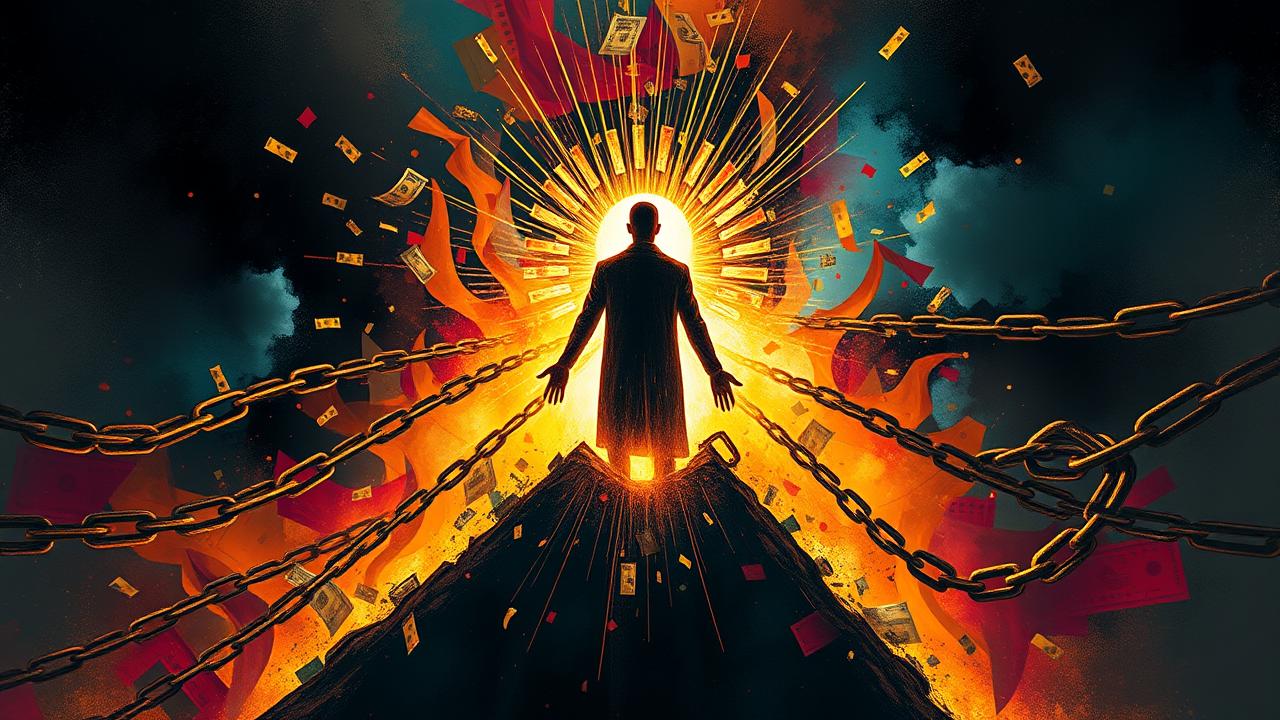The blue light of the phone paints a face in the dark, a mask of hope and terror. It’s 3:17 AM. The chart on the screen is a jagged green line climbing a mountain that doesn’t exist on any map. A heartbeat thunders in the quiet room, a frantic drumbeat against the silence of a life that feels stuck. This is the new frontier. This isn’t just about money; it’s about a primal scream for something more, a desperate gamble for a different future.
Welcome to the arena of cryptocurrency investing. It’s a place of breathtaking potential and soul-crushing risk. It’s not a passive hobby; it’s a full-contact sport for your capital and your courage. Forget the dry, academic explanations. This is about the raw, visceral reality of seizing control of your financial destiny in a world designed to keep you running in place.
The Brutal Truth in Brief
This isn’t a get-rich-quick pamphlet; it’s a survival guide for the digital wild. Here’s the unflinching reality:
- It’s a Battlefield, Not a Bank: Crypto is volatile. The mountains you see on the charts have valleys just as deep. Respect the chaos or it will consume you.
- Knowledge is Your Only Armor: Blindly throwing money at a coin with a dog on it is a ticket to financial ruin. Understanding the technology, the market, and the human psychology behind it is your only defense.
- Strategy Trumps Luck: Hope is not a strategy. You need a plan for buying, holding, selling, and securing your assets. Without one, you’re just prey.
- Fear Is the Enemy: Panic sellers lose. Greedy fools get wrecked. Mastering your own emotions is more critical than mastering the market.
The Digital Gold Rush: What Is This Madness?
At its core, what is cryptocurrency investing is the act of allocating capital to digital assets—like Bitcoin or Ethereum—with the expectation of generating a return. But that’s like saying a hurricane is “just some wind.” It misses the entire point.
This is investing in a rebellion. A rebellion against centralized banks, against institutional gatekeepers, against the slow, grinding erosion of your wealth through inflation. Each coin and token is built on a technology called blockchain, a distributed, immutable public ledger. Think of it as a digital book of records that can’t be secretly altered, controlled by a single entity, or shut down. It’s the technology of trust in a trustless world.
Investing here means you’re betting on that technology. You’re betting on a future where finance is more open, transparent, and accessible. And yes, you’re also betting that the thing you bought for a dollar will one day be worth a hell of a lot more. Sometimes it works. Sometimes it burns to the ground with spectacular fire.
Your First Step into the Arena
The diesel engine of his Kenworth was a low, constant hum, the soundtrack to a life spent on endless asphalt ribbons. For Harrison, a long-haul trucker, the world was a series of truck stops and loading docks, his cab a small, lonely kingdom. The ache in his back was as constant as the hum of the engine, a reminder of miles and years. It was in that solitude, bathed in the glow of his phone during a mandatory 10-hour break in a dusty Wyoming lot, that he decided to make a change. He wasn’t a gambler, but he was tired of feeling like the game was rigged against him.
So, how to start investing in cryptocurrency for a man like Harrison? Slowly. Meticulously. He devoured articles and videos, filtering out the hype. He chose a reputable, well-known crypto exchange like Coinbase or Kraken, seeing it as the safest on-ramp. He went through the verification process, a digital handshake that felt more significant than any load manifest he’d ever signed. His first purchase wasn’t a life-altering sum. It was $50. Just a small piece of Bitcoin. It wasn’t a lottery ticket; it was a foothold. A declaration that his future was his to build, one mile and one dollar at a time.
- Choose Your Battlefield (Exchange): Pick a large, reputable cryptocurrency exchange. Look for one with strong security features, reasonable fees, and a user-friendly interface.
- Secure Your Identity (KYC): You’ll need to complete a “Know Your Customer” process, typically involving your ID and some personal information. This is a standard anti-fraud measure.
- Fund Your Account: Connect a bank account or debit card to transfer funds into your exchange wallet.
- Make Your First Move: Start small. Buy a small amount of an established cryptocurrency like Bitcoin (BTC) or Ethereum (ETH). Feel the process. Understand it before you commit more significant capital.
Building Your First Crypto War Chest
Watching someone else walk the path can demystify the first terrifying steps. This video breaks down the process of building a portfolio from scratch. It’s not about flashy predictions, but about the bedrock principles of making your first buys, understanding the layout of an exchange, and thinking like an investor from day one. Absorb the practical mechanics so you can focus on the bigger strategy.
Source: How To Invest In Crypto As A BEGINNER In 2025 [Full Tutorial] via YouTube
Separating the Titans from the Trash
The question of the best cryptocurrencies to invest in is a trap. It presupposes a secret list, a cheat code to guaranteed wealth. There isn’t one. The real skill is learning to evaluate a project’s potential, to look past the marketing glitter and see the iron resilience—or fatal flaw—at its core. Your goal isn’t just wealth management; it’s risk assessment on the digital frontier.
The world is generally divided into three categories:
- The Kings: Bitcoin (BTC) and Ethereum (ETH). Bitcoin is the original, the digital gold standard, a store of value. Ethereum is the world computer, a platform for building decentralized applications (dApps). Most serious portfolios start here. They are the bedrock.
- The Contenders (Large-Cap Altcoins): These are other major projects with significant market caps, established use cases, and strong development teams. Think projects focused on payments, smart contracts, or interoperability.
- The Wild West (Mid- to Low-Cap Altcoins & Meme Coins): Here be dragons. This is where 100x gains and 100% losses live side-by-side. Investing here requires immense research, a high tolerance for risk, and a willingness to lose every penny you put in. For most, it’s a place to visit with “Vegas money,” not your life savings.
A Tale of Two Arenas: Crypto vs. Stocks
Thinking that cryptocurrency investing vs stock investing is about choosing the “better” one is a rookie mistake. It’s like asking if a soldier needs a rifle or a knife. They are different tools for different jobs in the grand scheme of advanced investing and wealth building.
The stock market is a regulated, centuries-old institution. It’s a paved highway with speed limits, guardrails, and established rest stops. You invest in a piece of a company’s profits and governance. It’s typically less volatile, more predictable, and moves at the speed of quarterly earnings reports.
Cryptocurrency is the jungle. It’s a 24/7/365 global market that never sleeps. The paths are being hacked out of the wilderness in real time. You’re investing in a protocol, a network, a piece of code you believe will change the world. The highs can be stratospheric, capable of generating life-altering wealth in months. The lows can be just as swift and infinitely more brutal, wiping out fortunes overnight with no safety net and no one to call.
The Abyss: Understanding the True Risks
A sleek, minimalist apartment felt more like a cage. Audrey, a freelance graphic designer, watched her friends’ Instagram stories with a knot of envy and panic tightening in her chest. Screenshots of crypto portfolios bursting with impossible green numbers. “To the moon!” they wrote. She felt herself being left behind, a spectator to a gold rush. The pressure was immense, a silent scream in her mind: Why not me?
She jumped. Not with research, but with fear of missing out. She poured a chunk of her savings—money she needed for taxes—into a trending meme coin. The rush was intoxicating. For two days, she was up 300%. She felt like a genius. Then, she woke up one morning, and it was gone. The chart was a vertical red line plunging into nothing. A “rug pull.” The anonymous developers had vanished, taking everyone’s money with them. The silence in her apartment was deafening, the shame a physical weight. This is the face of cryptocurrency investing risks—it’s not just numbers on a screen; it’s the hollowed-out feeling of hope turned to ash.
Recognizing the Predators
The crypto jungle is teeming with predators who feed on hope and ignorance. Learning how to avoid cryptocurrency scams is not an advanced skill; it is a basic survival necessity. Be ruthlessly skeptical. Trust no one.
- The “Too Good to Be True” Promise: Guaranteed high returns? A secret that will make you rich overnight? It’s a lie. Run.
- The Phishing Attack: You get an email or message that looks like it’s from your exchange, asking you to click a link and log in to “verify your account” or “claim a prize.” It’s a fake site designed to steal your password. Never click links. Always go directly to the official website.
- The Pump and Dump: A group of people coordinate to buy a low-value coin to inflate its price (the pump), then lure in FOMO investors, and sell off their holdings at the peak (the dump), crashing the price and leaving everyone else with worthless bags.
- The Impersonator: Someone on social media claiming to be a celebrity or crypto influencer offers to multiply your crypto if you send it to them. They won’t. Your money will be gone forever.
Your Fortress of Solitude: Building a Strategy
In his quiet study, surrounded by blueprints and schematics from a 40-year career as a civil engineer, Enzo approached the market with the same disciplined logic he used to design bridges. For him, the market’s chaos wasn’t something to fear; it was a system of forces to be understood and engineered. He wasn’t chasing lottery tickets. He was building a financial structure designed to withstand storms.
Enzo’s cryptocurrency investment strategies were simple, elegant, and powerful:
- Dollar-Cost Averaging (DCA): He never tried to “time the market.” Instead, he invested a fixed amount of money every two weeks, regardless of the price. This averaged out his purchase price over time, removing emotion from the equation.
- HODL (Hold On for Dear Life): He invested only in projects whose technology he understood and believed in for the long term (5+ years). He wasn’t swayed by short-term price swings. He was investing in the blueprint, not the daily construction noise.
- A Foundation of Research: He spent hours reading whitepapers, analyzing developer activity, and understanding the tokenomics of each asset. His decisions were based on data, not hype. Effective portfolio diversification wasn’t just about buying different coins; it was about investing in different technologies solving different problems.
Beyond the Basics: Advanced Reconnaissance
Once you’ve built your base camp and survived the initial scouting missions, you might start looking toward the horizon. This video explores the forces that move the larger market, offering a glimpse into the more complex strategies and macro-economic factors that influence both crypto and traditional stocks. This is for when you’re ready to evolve from mere survivor to seasoned strategist.
Source: The Secret Plan To Explode Crypto & Stocks via YouTube
The Vault: Guarding Your Digital Gold
Leaving your cryptocurrency on an exchange is like leaving a pile of gold bars on a table in a crowded public square. Sure, there are guards, but why take the risk? The history of crypto is littered with the ghosts of failed exchanges and massive hacks. Learning how to store cryptocurrency safely is the most empowering step you can take after your first purchase. It’s the moment you achieve true self-custody. It’s the moment it truly becomes yours.
Your Keys, Your Kingdom: Wallets Explained
The core principle is simple: “Not your keys, not your coins.” When you hold crypto in your own wallet, you control the private keys—the secret password that gives you access to your funds on the blockchain. Without them, no one can touch your assets. With them, you have absolute power. This is why cryptocurrency wallets explained is a critical lesson.
- Hot Wallets (Software Wallets): These are apps on your phone or computer. They are connected to the internet, making them convenient for frequent transactions but more vulnerable to online attacks. They are the wallet in your pocket.
- Cold Wallets (Hardware Wallets): These are physical devices, like a USB drive, that store your private keys offline. To make a transaction, you plug in the device and physically approve it. This makes them virtually immune to hacking. This is your personal bank vault. For any significant amount of crypto, a hardware wallet from a reputable brand like Ledger or Trezor is not a luxury; it’s essential.
The Command Center: Tracking Your Empire
Flying blind is for fools. You need a dashboard, a single source of truth that shows you exactly where you stand. Using cryptocurrency portfolio tracker tools is about clarity, not obsession. Checking prices every five minutes is a recipe for anxiety and bad decisions. A good tracker allows you to connect your exchange accounts and wallet addresses to see your entire portfolio in one place, track your performance over time, and make decisions based on calm analysis, not frantic emotion.
Look for tools like CoinStats or Delta that provide a clear overview without bombarding you with noise. It’s your mission control. Use it to stay informed, not to become addicted.
The Inevitable: Paying the Tax Man
There is a grim certainty in life, and that includes taxes on your crypto gains. Ignoring this is like ignoring a ticking time bomb. The rules can seem arcane and terrifying, but the basics of cryptocurrency taxes and reporting in many jurisdictions, including the U.S., treat crypto as property.
- Sell crypto for cash.
- Trade one cryptocurrency for another.
- Use cryptocurrency to buy goods or services.
The amount of tax you owe depends on how long you held the asset and your income level. It’s a headache, there’s no way around it. Use crypto tax software that connects to your exchanges to generate the necessary reports. It will save you a world of pain. Don’t let a victory in the market become a defeat at the hands of the tax agency.
The Armory of Knowledge
Essential Reads for the Crypto Warrior
Cryptocurrency Investing For Dummies by Kiana Danial: Don’t let the title fool you. This is your foundational boot camp. It covers the absolute essentials without condescension, giving you a solid platform to build upon.
The Bitcoin Investor by Michael Gonzalez: A focused deep dive into the king of crypto. If you’re going to understand the market, you must first understand its foundational asset. This book gets to the heart of why Bitcoin matters.
The Next Level Of Cryptocurrency Investing by Wayne Walker: When you’ve mastered the basics and are ready to move beyond just buying and holding, this guide explores the more advanced strategies and asset types that define the cutting edge of the space.
Questions from the Trenches
Is crypto a good investment, or am I a fool for even thinking about it?
It can be a powerful investment, but it’s not a “good” or “bad” one in a vacuum. It’s a high-risk, high-reward asset class. You’re not a fool for being curious; you’d only be a fool for investing without education and a clear strategy. Its place in your financial life depends entirely on your risk tolerance, your time horizon, and your commitment to learning. For some, it’s a path to incredible growth. For others, it’s a fast track to ruin. The difference is knowledge.
Can you really make $100 a day with crypto?
Yes. And you can just as easily lose $1,000 a day. Chasing daily profit targets is the mindset of a day trader, a high-stress, high-risk profession that chews up and spits out most who attempt it. A more resilient approach for most people is to focus on long-term growth. Instead of asking how to make $100 today, ask how your cryptocurrency investing choices today can build substantial wealth over the next five years.
I got burned on a bad investment. How do I recover?
First, breathe. Acknowledge the loss. It’s a tuition payment to the school of hard knocks. Don’t “revenge trade” to try and win it back quickly; that’s how you compound the disaster. Step back. Re-evaluate your process. Was it a lack of research? Were you driven by FOMO like Audrey? Use the painful lesson to forge a stronger, smarter strategy. Every veteran of this market has scars. The ones who succeed are the ones who learn from them.
The Rabbit Hole Awaits
The journey of a thousand miles begins with a single step. Here are some places to continue your expedition.
- Investopedia Cryptocurrency Section: For clear, concise definitions of key terms and concepts.
- r/CryptoCurrency: A massive community for news, discussion, and a real-time pulse of the market. Filter with caution.
- Coinbase Learn: A great resource for beginners, with simple explainers on various cryptocurrencies.
- Investing.com Crypto: For live price charts and market data.
- Charles Schwab Cryptocurrency: A look at how traditional finance is starting to integrate with crypto assets.
Your Move
The screen still glows in the dark. The jagged lines of the charts will continue their chaotic dance whether you participate or not. But now, you know the terrain. You’ve seen the triumphs and the tragedies. You understand the weapons and the armor required to survive, and even thrive, in this new world of cryptocurrency investing.
The power was never in the code or the coins. It was always in you. The power to learn, to plan, to execute with discipline, and to rise again after you get knocked down. Your next step isn’t to bet your life savings. It’s to take one small, deliberate action. Read a whitepaper. Open an exchange account. Make a tiny, educational purchase. Take the first step toward claiming your power.







